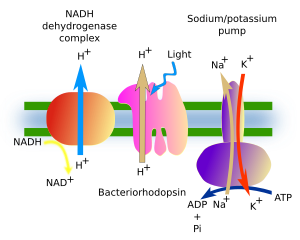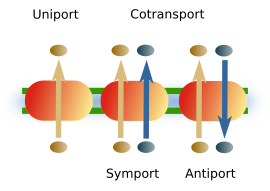Membranes are barriers to the free diffusion of ions and electrically charged molecules. However, ions and many molecules, such as carbohydrates, peptides, and some lipids, have to cross cell membranes to perform their functions. For example, glucose needs to enter the cell to be used as energy source, and ions are necessary for electrochemical gradients. Around 10 % of the genes of a cell are involved in membrane transport, showing how important this mechanism is. As we mentioned in previous pages, concentration gradients across membranes are involved in many cell functions. Cells need to take control of these gradients, so that they can be generated, modified and removed. A deep knowledge of the membrane transport is useful for knowing how cells work, but also for other purposes like to improve the synthesis of drugs that need to cross the cell membrane to function intracellularly.
In cell membranes, there are proteins specialized in transporting molecules and ions for metabolism or electro-chemical gradient purpouses. They are transmembrane proteins that can be divided in three groups: pumps, transporters (or carriers) and channels.
1. Pumps
Pumps are transmembrane proteins for moving ions or small molecules against their concentration gradients across membranes (Figure 1). They are also known as primary active transporters. The energy for these transport can be obtained from different sources, such as light, oxido-reduction chemical reactions, and from ATP hydrolysis, which is the most frequent source. Pumps generate gradients because they transform chemical or electromagnetic energy into electrochemical gradients that are used by many cellular processes. There are not many different classes of pumps, and they can be classified according to their source of energy. a) Light. For example, bacteriorhodopsin uses light to form a proton gradient in membranes of some prokaryotes. b) Oxidation-reduction potential. Complexes of the respiratory chain of mitochondria uses oxidation-reduction changes to move protons across the inner membrane. c) ATP. There are several types of pumps in this group. Some of them transport protons into organelles, such as those present in the lysosomal membranes, a process that results in the acidification of the lysosomal lumen and facilitates the degradation of molecules by the acid hydrolases. To this group also belong both mitochondria and chloroplast ATPases, since they use the proton gradient for synthesizing ATP. However, they can also perform the opposite process in some circumstances, that is, generate a proton gradient by consuming ATP . Another type of pumps uses ATP for transporting several ions. The sodium/potassium pump is in charge of the concentration gradients of the plasma membrane that make possible neuronal excitability, cell muscle contraction, absorption of digested molecules in the intestine, and many more processes. We can imagine how important this pump type is considering that it consumes up to 25 % of the total cellular ATP of animal cells. To this family of pumps also belong those responsible for the transport of cations, such as calcium. For example, one of them takes calcium out of the endoplasmic reticulum during each muscle cell contraction. Finally, there are the ABC pumps that use ATP to move a large variety of molecules across membranes. They are present in all studied eukaryotic cells so far, and are able to transport ions, carbohydrates, amino acids, and small polypeptides.

2. Transporters
Transporters are transmembrane proteins that make use of electrochemical gradients to move molecules across membranes (Figure 2). This type of movement is known as facilitated diffusion. It is passive diffusion because the movement is driven by the existing electrochemical gradient, and it is facilitated because the transporter is the element that allows molecules to cross the membranes. Transporters are very diverse and abundant. There are more than 100 families, and they can be found in all cell membranes. Before crossing the membrane, the molecule to be transported must be first recognized by the transporter, and then a conformational change of the transporter occurs, which allows the transfer of the molecule across the membrane. Uniport transport occurs when one molecule is moved bya a concentration gradient, and it is carried out by the so-called primary transporters. Co-transport is when two types of molecules are transported at the same time. Co-transport may be antiport, when the two types of molecules travel across the membrane in opposite directions, and symport, when they both are moving in the same direction. During co-transportation, one type of molecule is propelled by its concentration gradient, whereas the other uses this energy to move against its own concentration gradient. For example, cardiomyocytes use the Na+/Ca2+ transporter to move Ca2+ against gradient concentration from the cytosol to the extracellular space by using the energy of the movement of Na+ from the extracellular space to the cytosol by concentration gradient. During antiport, similar elements are exchanged: cation for cation, anion for anion, sugar for sugar, and so on. However, different types of elements can be transported during symport processes. For example, in the intestine epithelium, enterocytes use the incoming stream of Na+ to enter D-glucose. The transporters doing co-transport are sometimes called active secondary transporters because they use the energy stored in gradients, but the ATP is actually spent in generating that gradient.

3. Channels
Channels are transmembrane proteins containing hydrophilic passages that communicate both sides of the membrane (Figure 3). They have the ability to open and close the passage depending on certain signals. The main function of channels is to change the ionic gradients in order to modify the membrane electrochemical potentials, so that those changes turn into information for the cell. They are also necessary for secretion and absorption of substances, as in the kidney. In any case, it is always a passive movement of ions through the channels, since ions move by concentration gradient. The selection of ions going through a particular channel depends on the diameter of the hydrophilic passage. There is a wide variety of channels: Na+ channels, Ca2+ channels, K+ channels, Cl-, and some others. Aquaporin is a different type of channel that allows water to cross the outer mitochondrial membrane without restrictions. There are voltage dependent channels, mechanosensory channels, ligand dependent channels, termoreceptor channels, etcetera, depending on what stimulus is regulating the channel behavior. If this regulation is produced by changes in the value of the electrochemical membrane potential, channels are known as voltage denpendent channels. They may also be ruled by ligands (ligand-gated channels) or by chemical modifications, such as phosphorylation. Channels carry out essential functions for organisms such as muscle contraction, neuronal excitability, polyspermy prevention (avoiding more than one sperm fusing with the oocyte during fertilization), and many others.

-
Bibliografía ↷
-
Bibliografía
Alberts B, Johnson A, Lewis J, Raff M, Roberts K, Walter P. 2002. Molecular Biology of the Cell, 4th edition. New York: Garland Science. SBN-10: 0-8153-3218-1
-
 Synthesis
Synthesis 